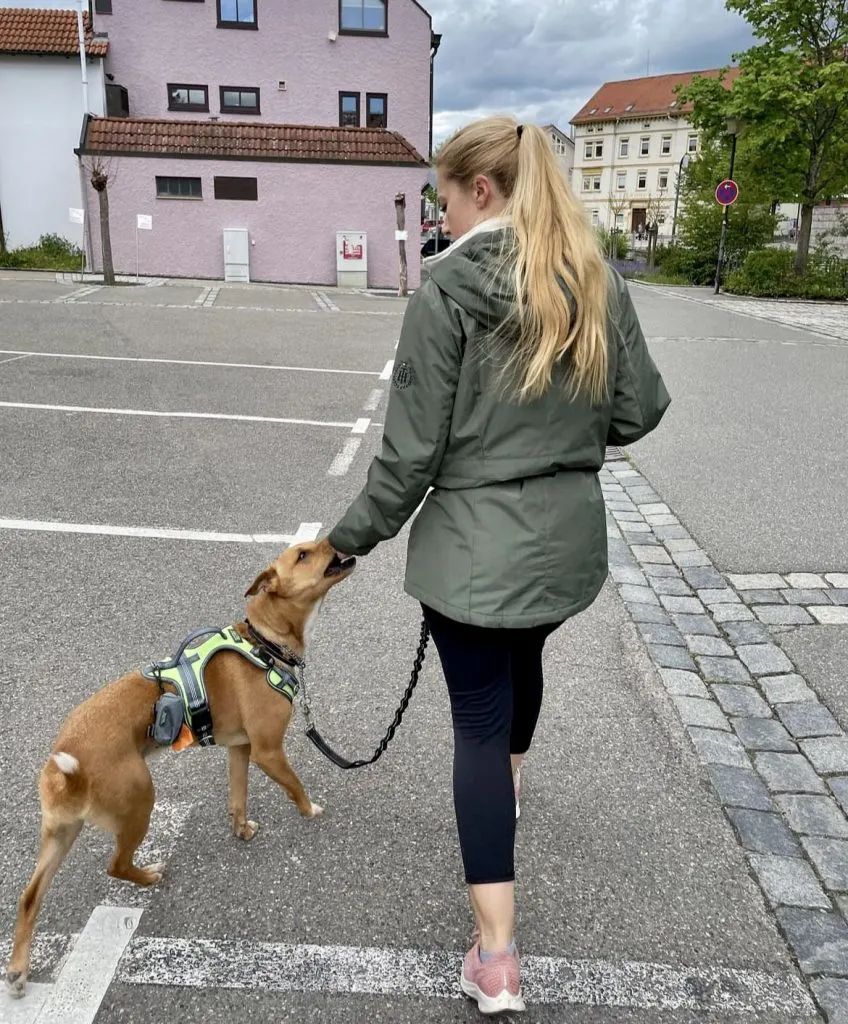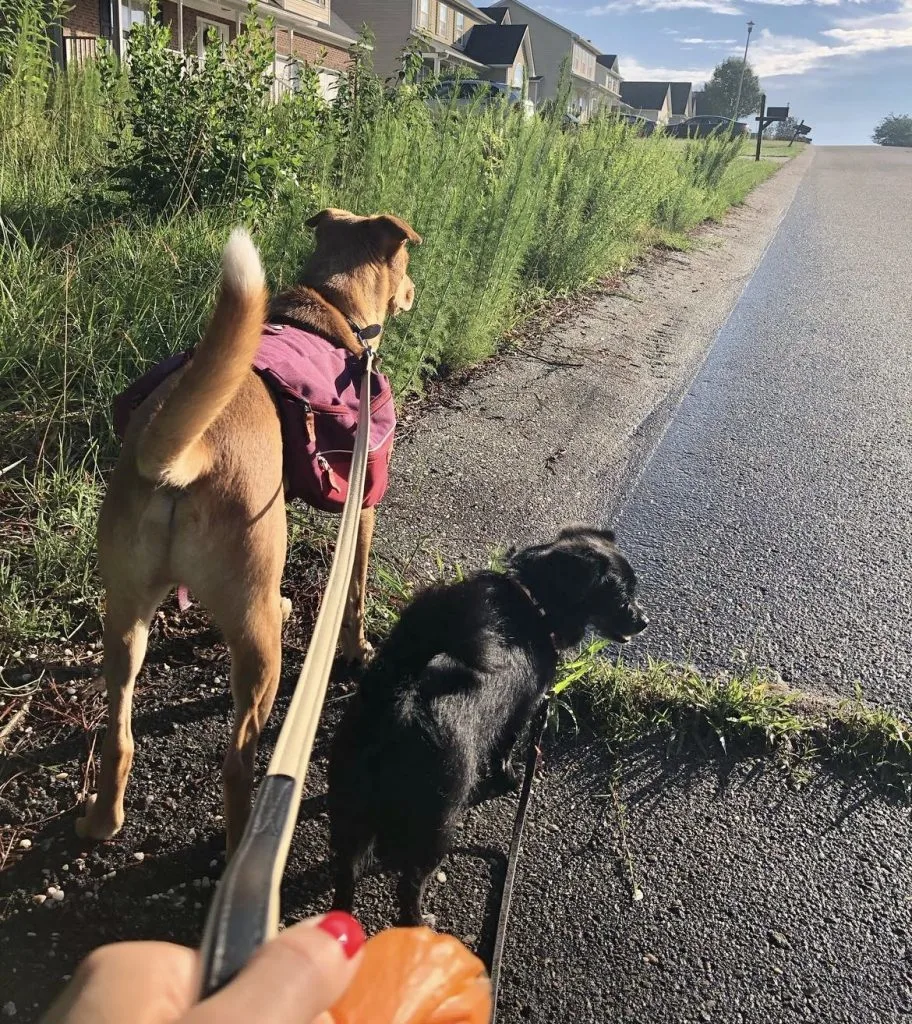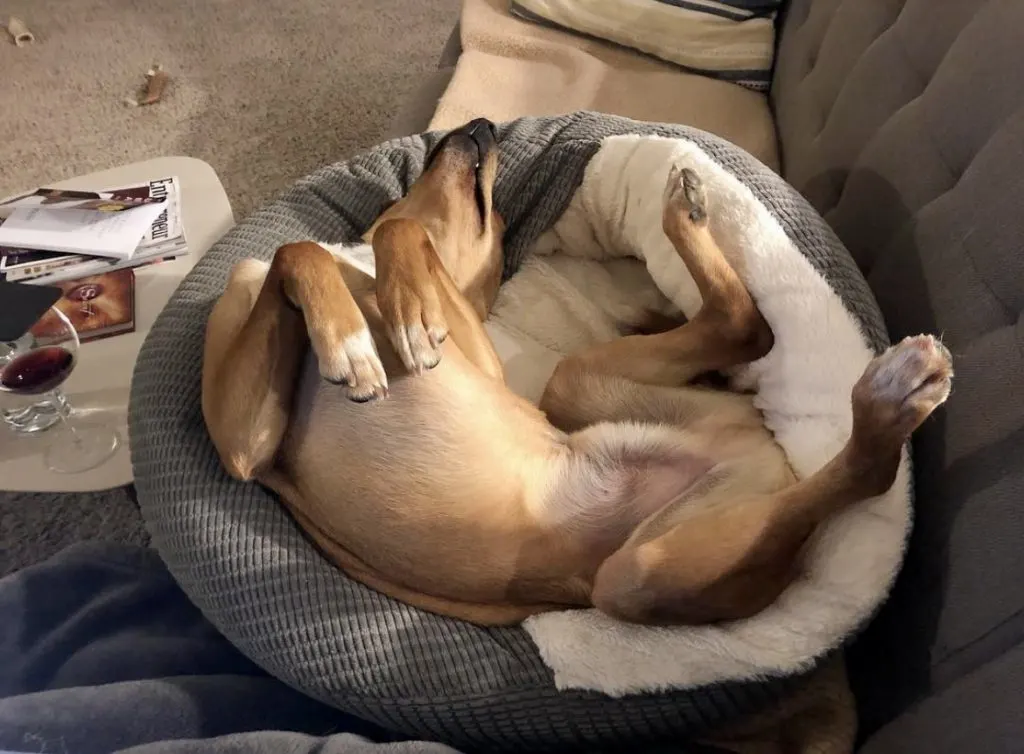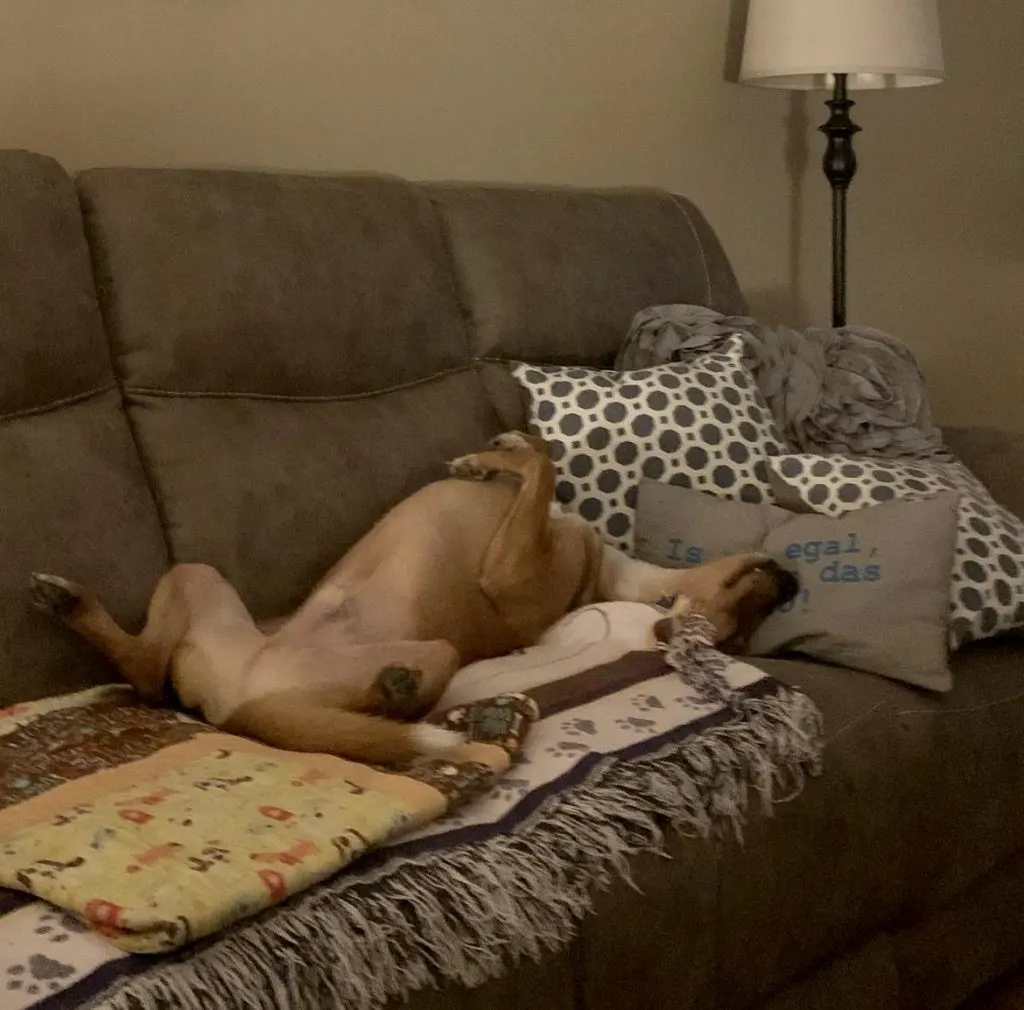If you’re looking to adopt a shelter pup, you may have heard of and are now wondering what is the 3-3-3 rule of adopting a rescue dog?
It’s also known as the rule of 3 for dogs and lets you know what to expect as far as the adjustment period when you’re bringing a shelter dog home.
Depending on the dog’s previous life, that’s usually a somewhat different experience than bringing a new puppy home that you purchased from a reputable breeder.
Looking back at my own foster-failure experience with my pup Wally in 2019, this is a good example of the 3-3-3 rule.
That’s why I thought I’d share it with you along with tips for setting your rescue dog up for success.
I’ll also provide an answer to the question Will my rescue dog ever be normal?
What Is The 3-3-3 Rule of Adopting a Rescue Dog?
The 3-3-3 rule lays out 3 common phases that rescue dogs experience after their adoption. To be more specific, it consists of the first 3 days, 3 weeks and 3 months with their forever family.
During the first 3 days of living at their new home, most rescue dogs are overwhelmed by their new surroundings.
Fast forward 3 weeks and they’re starting to settle in.
3 months down the road, they’re beginning to build trust.
Now, this timeline can vary slightly from dog to dog depending on:
- how long they’ve been at the shelter
- how many times they’ve been re-homed
- how naturally shy or confident they are
So while you can add or subtract a few days here and there, the 3-3-3 rule of adopting a rescue dog gives you a good general idea of what to expect with your new furry friend.
Looking back at Wally’s first 3 months with me, there was definitely a noticeable change in his behavior!
Just for reference, Wally’s a Feist mix whom I adopted from a rescue organization in NC in late January 2019.
I’ve written about him here on the blog before in the posts What is a Feist Dog Breed? and My Dog’s Training Progress – One Year Later.
Back then, he was about one year old.
By that time, he had already been re-homed twice, experienced shelter life and what it’s like to be pulled from a shelter by a rescue organization!
Whew, quite a bit for a one-year old dog, right?
That said, Wally’s living proof that even a dog who’s been to multiple homes and a stressful shelter environment can successfully adjust to a new owner.
It just takes some time, structure, patience and lots of love!
3-3-3 Rule – The First 3: Days Overwhelmed With New Surroundings
The first 3 days are the first part of the 3-3-3 rule.
These initial days at a new home can be difficult for the dog and challenging for their new owner(s).
After all, dogs don’t understand when we try to explain to them that nothing bad is going to happen!
No matter how many times we tell them that they’re moving in with their furever family and out of their small shelter space, they don’t get it.
As crazy as it sounds, they may even miss the deafening sound of dogs barking at the shelter. At least for the first day or so.
They may be downright suspicious as to why they’re being moved around again, particularly if they’ve already experienced that.
So the result is usually a somewhat nervous, overwhelmed, cautiously curious dog who won’t show their true nature quite yet.
Instead, prepare for a dog who’s likely going to be resting a lot! That’s certainly what my pup Wally did during his first couple days with me.
So make sure that you have a crate, bed or comfy mat set up when you bring your new pup home. It should be in a place where they can feel safe yet not be alone. This could be in a corner of your living room, kitchen, your Master or a centrally located laundry room.
You may also be cleaning up a few accidents even if your rescue dog is house trained. Stress such as re-homing can cause house soiling in dogs, so be aware and make sure you have some cleaning supplies for dog urine handy.
For carpeted areas, our favorite for cleaning up potty messes is Rocco & Roxie Stain and Odor Remover.
If you have kids, let them know that their new furry friend will need a few days to get used to his new family and that he may not be ready for hugs quite yet.
As a matter of fact, many dogs truly dislike being hugged, so it’s something to be aware of.
That way, your kids know what to expect and how to behave, too!
Wally’s First 3 Days With Me
When I picked Wally up from the rescue organization, we had about an hour’s drive ahead of us to get back home.
Before I took him to see my car though, we went for a 45 minute walk around his neighborhood.
I wanted to give him the opportunity to pee, poop, stretch his legs and get to know him on leash at least a little bit.
The First Car Ride
After our walk, he was very curious about my car and had no problem jumping right in as soon as I opened the back door.
Since I made him wear a car harness with a seat belt attachment for a safe ride home, he wasn’t able to roam around in the car.
However, it still gave him enough space to stand up, walk around a little and look out of the window, but he didn’t.
Instead, he curled up into the tiniest ball of fur ever. And that’s exactly how he stayed until we pulled up into my driveway one hour later.
When I compare that behavior to how he is in the car these days, it’s quite different. He’s still seat belted in, but he ALWAYS stands for the first 20-30 minutes and pays close attention to where we’re going.
He also loves looking out of the window, taking in the changing scenery of what rolls past us.
Once we hit the highway and drive faster, he’ll lie down, but not curled up into a tiny fur ball.
The First Day At Home
When we made it home on our very first day together, I took him for another walk around his new neighborhood prior to going inside. It was one more potty break paired with taking in all the new smells.
When we finally went inside, I gave him the tour of the downstairs and kept him leashed as we walked around.
I ended up closing a few doors such as my office door, spare bathroom, guest bedroom and laundry room door. That way, he “only” had access to the Master bedroom where he was going to sleep at night, the living room and the kitchen/dining area.
I showed him his water and food bowls as well as his comfy new bed next to the couch.
He also inherited my late pup Missy’s crate which I had set up in the living room. I left the door open but didn’t expressly introduce him to it. That way, he could explore it when he felt like it on his own terms.
After showing him around, I took his leash off, sat down on the couch with some coffee and just let him do his thing.
He ended up walking around some more, took a quick sniff at Missy’s old crate, drank some water and then actually laid down on his new bed.
Should I Let My Rescue Dog Sleep With Me?
He ended up sleeping quite a bit that first day, which is normal and to be expected. After all, Wally got a lot of new input which drained him of his mental energy.
As far as setting him up for the night, I moved his bed and the crate into my bedroom to give him a few options. He ended up starting out on his bed but was pretty quick about changing his mind and hopping up on mine!
That was fine with me as that’s where Missy had slept during her last few months before cancer took her from me.
While I personally didn’t mind him sleeping on my bed, it’s up to your personal preference whether or not you let your rescue dog sleep with you.
They’ll also get used to sleeping in a crate or in a doggie bed. By the way, these days Wally sleeps in his crate at night.
But on the first few nights, Wally slept curled up at my feet and was a good boy.
The next few days were more or less a repetition of the first one minus any car rides. We went for lots of leashed walks in my neighborhood, watched squirrels in my backyard and secretly observed one another!
I feel like sometimes, he was watching me out of the corner of his eye, thinking OK lady, when are you going to take me back? while I was thinking OK pup, do you miss your previous owner?
3-3-3 Rule – The First 3 Weeks: Settling In
The first 3 weeks with your rescue dog are the second part of the 3-3-3 rule.
Let me jump right in and share what I think really helps set you up for success with your rescue pup during this phase:
- create new routines
- stick to dog walking schedules
- take note of your dog’s quirks & preferences
- establish suitable training and feeding patterns
After the initial 3 days that I had taken off from work, Wally started to feel more and more at home with me.
He was enjoying our daily long morning walks followed by chasing squirrels in the yard, and then having his breakfast.
As long as he was properly exercised, he also didn’t mind being crated for a few hours while I took care of my dog walking clients.
By the way, his diet was something that I changed very quickly. Prior to life with me, he was fed dry kibble.
Now that he lived with me, I switched him over to raw dog food. He took to it right away and it also helped get rid of his itchy skin.
To learn more about raw dog food, click here.
Noticing Some of Wally’s Quirks
However, I noticed that he was counter surfing every chance that he got and ripped up all the plush toys I gave him!
As far as playing with balls and other dog toys, he wasn’t interested in any of that.
He also didn’t know the “down”, “stay” or “leave it” commands…that made it extra interesting trying to remove toy stuffing from his mouth.
Or anything else he didn’t feel like letting go of!
I remember our very first outing to a local pet retail store where he stole one of those extra large Tuffy dog toys.
They were sitting on a shelf within his reach, so he just grabbed one and refused to let go of it, even in exchange for treats!
After I ended up paying for it, I created a list of things to work on/avoid in order to be less frustrated with some of his behavior and not set him up for failure.
For instance:
- Keep him on a short leash tab inside pet friendly stores
- Don’t leave ANY food out on the kitchen counter
- Practice obedience commands on a daily basis
- No more plush toys at home
That said, your rescue dog will come more and more out of their shell during this second phase of the 3-3-3 rule.
As you notice specific problem behaviors or training opportunities, I suggest you write them down and start working on fixing them.
Until you’ve eliminated a problem behavior, try to remove its triggers from your dog’s life as much as possible.
If the problem behaviors such as dog reactivity or separation anxiety are really bad, don’t hesitate to involve a professional dog trainer.
3-3-3 Rule – The First 3 Months: Building Trust & Bonding
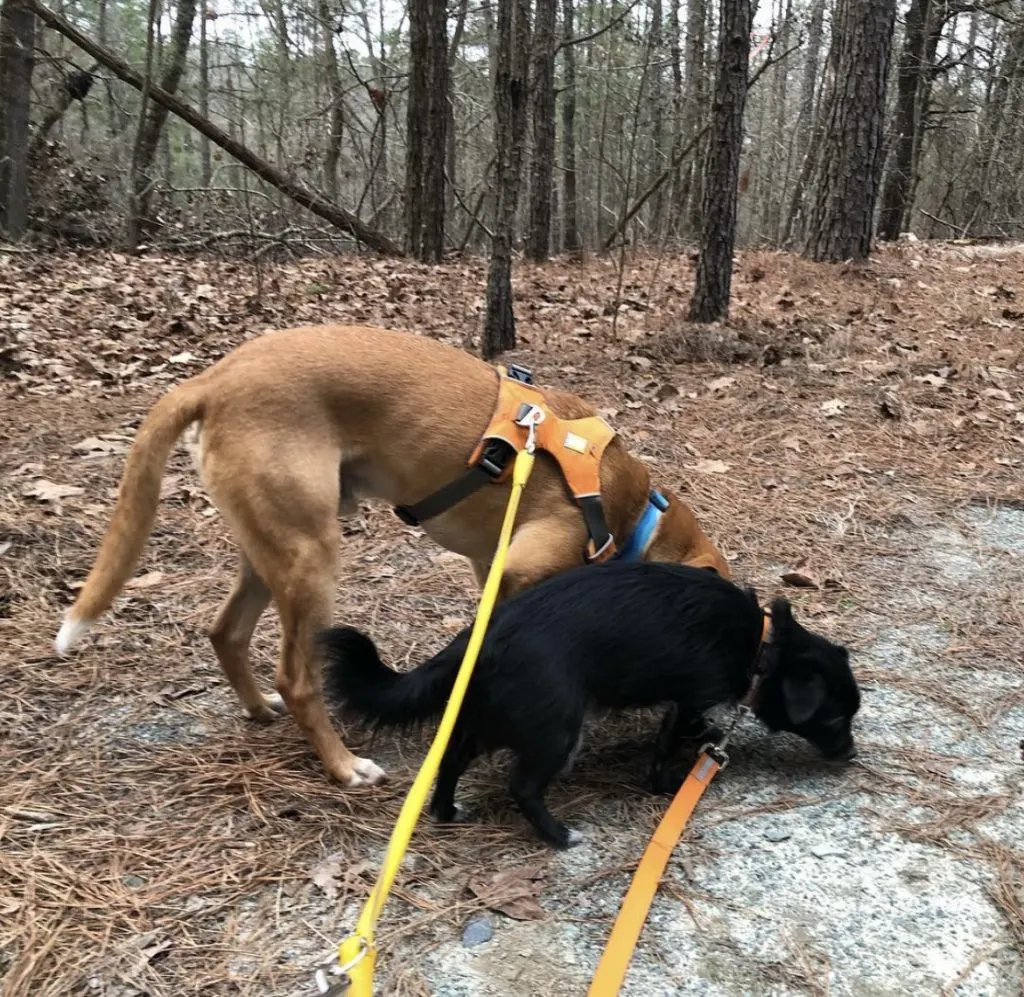
The first 3 months are the last part of the 3-3-3 rule.
At this stage, your rescue dog is spending more and more time with you. That’s the key to building trust and bonding with you.
How Do You Bond With a Rescue Dog?
Any activity you do together with your rescue dog will make your bond stronger. This includes but is not limited to:
- Feeding routine
- Grooming time
- Walking together
- Relaxing together
- Exploring new hiking paths
- Going on road trips together
- Learning new tricks like “roll over” or “shake”
- Dog sports like agility, nose work & canicross
- Teaching new obedience commands like “stay” and “come”
As you do more activities together, you’ll also find out more and more about your pup’s personality and preferences.
For example, one month into life with Wally, I took him to the coast in NC where we met up with a friend and her dog, a mellow Golden Retriever called Lucy.
I wholeheartedly expected Wally to love the ocean as much as Lucy does and also as much as my late pup Missy did.
But, not so much.
As a matter of fact, Wally’s also not big on getting his paws wet whenever it can be avoided, so there’s that. He did, however, want to chase ALL of the seagulls!
That said, signs of a strong bond with your rescue dog are:
- Happy tail wags
- Making eye contact
- Greeting you happily at the front door
- Asking for/enjoying scratches and belly rubs
I remember the first time Wally felt comfortable/silly enough to lie upside down in his dog bed and expose his belly. That was about 2.5 months into our journey together.
The upside down position is probably one of the biggest compliments you can get from your pup. That’s because it leaves them very vulnerable and they trust you to protect them!
Since then, Wally’s belly-up position has been one of his favorites and usually indicates that he’s ready for some playtime.
Will My Rescue Dog Ever Be Normal?
If by normal you mean any of the following, then yes, your rescue dog will be normal as they start feeling comfortable in their new home and won’t display any more:
- Accidents/territory marking inside (unless they’re sick)
- Destructive behavior
- Separation anxiety
- Excessive barking
- Food aggression
- Resourcing guarding
Remember that time and patience are key ingredients that will help your rescue dog act “normal”.
Physical Exercise Helps with A Lot of Issues
Also, please know that physically tired dogs are much less likely to act out, so it’s important to offer your rescue pup an adequate amount of exercise.
Just spending time in the yard does not count!
Your pup will need daily walks and maybe even runs or bike rides. That depends on their respective energy levels.
One tool I recommend are doggie backpacks.
I got Wally one during his second month with me. He does have a decent amount of energy and I’m not much of a runner, so the backpack makes up for that!
Pet Sitters/Dog Walkers as Potential Support System
If you’re not working from home and are spending long hours at the office, consider hiring a professional pet sitter/dog walker or dog runner.
They can come to your home to give your pup a break from a long day alone. Besides giving them a potty break, some exercise and TLC, this can also help prevent separation anxiety!
To find a professional dog walker near you in the US and in Canada, check out Pet Sitters International Find a Pet Sitter Tool.
Fun fact: I used to work in the pet sitting and dog walking industry for 9 years. It was a lot of fun and very rewarding to be greeted by my doggie (and feline!) clients, but it’s also a lot of hard work.
Feeling Safe & Loved
Once your rescue pups realize that no one takes their food, treats and toys away and that they have a warm, safe place to snooze, they’ll relax and settle in like any good pup.
Even if you’ve never crated your previous dogs, give it a try with your rescue pup. Kennels can easily be turned into a safe den your rescue pup will likely be drawn too if they’re skittish and fearful.
You can line it with a towel or crate pad and cover it with a blanket for an extra layer of safety.
Define Your Normal
Other than that, you’ll have to define your “normal”!
It’s important to understand that every dog is different and has their quirks and preferences specific to them.
If you adopt a pup from a breed specific dog rescue, it’ll be a bit easier to predict some of your dog’s preferences than if you adopt a lovable mutt.
For example, Retrievers and Poodles will likely love the water, while herding breeds like Shepherds and Border Collies will have a natural drive for herding!
So if you’re looking for a specific form of “normal” in a new pup, you may want to focus on breed specific rescues. They’re more likely to have dogs who fit your definition of “normal”.
That’s not to say that you won’t find a water loving Boxer or Bulldog mix at a regular shelter, but you just can’t be sure.
That said, there’s always the off chance that a specific breed doesn’t have all of the characteristics they’re “supposed” to have, so there’s just no way of knowing for sure!
Learn To Appreciate Your Dog For Who They Are
Also, no dog will ever be like any of your previous dog(s).
I noticed that towards the beginning of Wally’s and my journey together, I made the mistake of assuming he’d like everything Missy enjoyed.
Including her love for the water.
Besides taking Wally to the ocean, I had also planned on taking him swimming at the awesome doggie pool not far from our house, Riverbark Pet Retreat in Spring Lake, NC.
Missy loved swimming there, but when I noticed that Wally’s not big on swimming on our day trip to the ocean, I quickly forgot about those plans.
Besides his dislike for activities in the water, I also had to get used to the joy he finds in ripping up soft things. Missy never did that.
This cumulated in his destruction of the -admittedly very soft- plush dog bed.
So I went ahead and replaced the soft dog bed with a raised dog cot.
It wasn’t until 4 years later, in 2022, that I made another attempt at providing him with a more plush lining for his cot.
And what do you know, he never tried to rip that one apart! But he still can’t resist destroying a plush dog toy!
The 3-303 Rule: 3 Milestones of a Rescue Dog
So now you know that the 3-3-3 rule defines the different phases a rescue dog goes through when adjusting to their new owners and home.
The first 3 days, 3 weeks and 3 months are 3 very important milestones that anyone should be aware of when they consider adopting a rescue dog.
Initially, you can expect your shelter dog to be more on the shy, reserved side. That’s also when they’ll rest a lot.
Once they spend more and more time with you and/or your family, they’ll start coming out of their shell.
When that happens, you’ll see their true personalities along with the little quirks and preferences that make each pup unique.
After about 3 months, your rescue dog will truly start to feel at home with you.
Remember to give them as much time as they need to adjust – some dogs may need a bit more time than 3 months, and some may need less.

